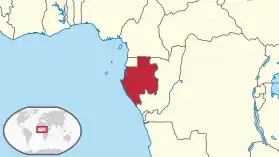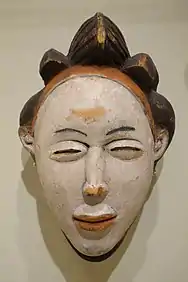Punu people
The Punu or Bapunu (Pungwe|Pungu|Uréwé) (Sira, Ban Sira), are a Bantu meta-ethnicity of Gabon and the Republic of Congo.

History
According to Magang-Ma-Mbuju and Mbumb Bwass the Punu people come from the people called «Jagas» and come from Kasaï and Zambezi. According to them, it was the Punu people who had invaded the kingdom of Kongo in 1568 and they were known as Jagas.[1]
Claude Hélène Perrot said that before the publication of the work of these two authors (Magang-Ma-Mbuju and Mbumb Bwass), many studies devoted to the Jagas problem had shown that this warrior group was of diverse origins, B.M. Batsikama and M. Ipari had concluded that the invaders of Mbanza Kongo in 1568 were populations of Kongo origin. The Punu people migrated into The Republic of the Congo in the 16th century and migrated into Southern Gabon in the 18th century.[1][2]
Culture
White masks

One of the well known Punu art objects are the white masks with nine dots on the forehead symbolizing the nine Punu clans, now known as the Punu masks. The masks are life size, they can cover a person's face. They are worn by the dancers in south Gabon. When there is a major community event the dancers wear these masks, one major event would be a dance performed for a secret society. Europeans have been trying to discover the Punu society for a long time, but not until June 1865 did the first European discover the first white mask. Later in 1925-30 Europeans had more access to the societies and the secrecy was less than before.[3]
Black masks
.jpg.webp)
Black masks in Punu culture were worn by dancers as training masks, which perform first to announce the arrival of the white mask dancer which is more experienced. Sometimes when a misfortune happens to a group they take white masks and paint them black. This type of mask is only danced with in the dark at night. Different from the other two masks, these masks are rarely found in a museum because they used to hide them very well, due to the belief that they are dangerous and they have an evil nature.[4]
Beliefs
The Punu believe in their God Nyambye, they feared evil spirits, they used to do chirurgical operations after someone death to find out the cause of the death however if the cause of the late person could not be found it was then the wizard (mulosi) from the family circle who should be held responsible. People were jealous of successful people and they believe that their jealousy would cause the successful person harm or death. Illness was always seen as a work of an evil spirit and the only way to heal was by a special ritual to cast away the evil spirit's work.[5]
External links
References
- Claude Hélène Perrot, Lignages et territoires en Afrique aux XVIIIe et XIXe siècles : stratégies, compétition, intégration, KARTHALA Editions, 2000, p. 59–60. (in French)
- Guy Claver Loubamono-Bessacque in Yves Le Fur (dir.), 2017, pp. 18–25, en particulier p. 21. et Alisa LaGamma, Muses de l'avant-garde et leur origine punu, carte des migrations depuis le XVII e siècle, p. 159. (in French)
- Perrois, Louis. (2008). Punu. Grand-Dufay, Charlotte, 1947-. Milan: 5 Continents. pp. 7–11. ISBN 978-88-7439-401-2. OCLC 244301482.
- Perrois, Louis. (2008). Punu. Grand-Dufay, Charlotte, 1947-. Milan: 5 Continents. p. 49. ISBN 978-88-7439-401-2. OCLC 244301482.
- Perrois, Louis. (2008). Punu. Grand-Dufay, Charlotte, 1947-. Milan: 5 Continents. p. 32. ISBN 978-88-7439-401-2. OCLC 244301482.